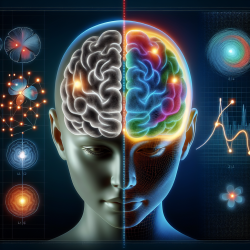Introduction
Understanding the neural mechanisms that support language recovery after a stroke remains a pivotal challenge in speech-language pathology. Recent research by Sebastian et al. (2016) offers valuable insights into how language recovery occurs at a network level following a left posterior cerebral artery (PCA) stroke. This study emphasizes the importance of both inter- and intra-hemispheric connectivity in the recovery process, providing a new perspective on how practitioners can enhance therapeutic outcomes for individuals with aphasia.
Key Findings from the Research
The study utilized task-based and resting-state functional magnetic resonance imaging (fMRI) to assess language recovery in four participants with PCA stroke. The research highlighted several critical findings:
- Increased Connectivity: Improvement in naming accuracy from the acute to the chronic stage was associated with increased connectivity within and between left and right hemisphere language regions.
- Persistent Deficits: Participants with persistent moderate naming deficits showed weak and decreasing connectivity longitudinally within and between language regions.
- Network View of Recovery: The study supports a network view of aphasia recovery, suggesting that the balance of connectivity between language-specific regions is crucial for optimal recovery.
Implications for Practitioners
For speech-language pathologists, these findings underscore the importance of considering the entire language network rather than focusing solely on localized brain regions. Here are some practical ways practitioners can apply these insights:
- Holistic Assessment: Incorporate assessments that evaluate both hemispheric connectivity and specific language functions to better understand each patient’s unique recovery pattern.
- Tailored Interventions: Design therapy plans that not only target specific language deficits but also aim to enhance overall network connectivity. This could include exercises that engage both hemispheres.
- Longitudinal Monitoring: Use longitudinal assessments to track changes in language network connectivity over time, adjusting therapeutic approaches as needed to align with recovery progress.
Encouraging Further Research
The study by Sebastian et al. opens several avenues for further research. Practitioners are encouraged to explore how different therapeutic interventions might influence network connectivity and language recovery. Additionally, investigating the role of neuroplasticity in recovery could provide deeper insights into effective rehabilitation strategies.
Conclusion
The research on network-level language recovery following PCA stroke provides a compelling argument for adopting a more integrated approach to aphasia therapy. By focusing on the connectivity between language regions, practitioners can potentially enhance recovery outcomes for individuals with aphasia.
To read the original research paper, please follow this link: Imaging network level language recovery after left PCA stroke.










